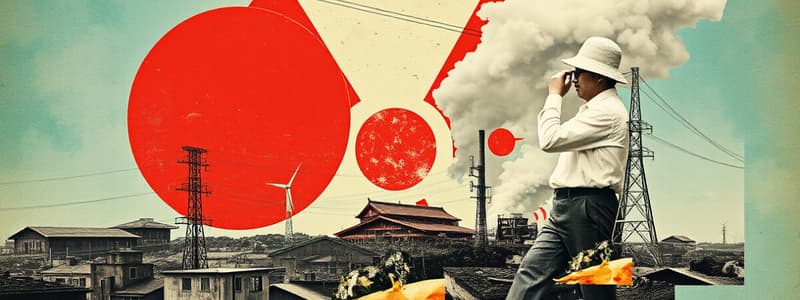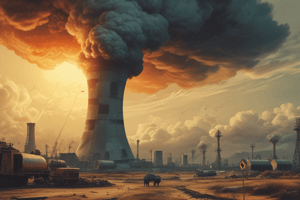Podcast
Questions and Answers
Which country announced plans to close all nuclear plants by 2022?
Which country announced plans to close all nuclear plants by 2022?
- United States
- France
- Japan
- Germany (correct)
Japan initially continued to operate all of its nuclear reactors after the tsunami in 2011.
Japan initially continued to operate all of its nuclear reactors after the tsunami in 2011.
False (B)
What significant event on March 11, 2011, led to the Fukushima disaster?
What significant event on March 11, 2011, led to the Fukushima disaster?
A 9.0 magnitude earthquake.
The _______ exclusion zone was established around the Fukushima disaster site, displacing thousands of residents.
The _______ exclusion zone was established around the Fukushima disaster site, displacing thousands of residents.
What type of contamination was a major consequence of the Fukushima disaster?
What type of contamination was a major consequence of the Fukushima disaster?
Match the following effects with their corresponding descriptions:
Match the following effects with their corresponding descriptions:
Public opposition to nuclear energy decreased after the Fukushima disaster.
Public opposition to nuclear energy decreased after the Fukushima disaster.
What were some adverse effects observed in local wildlife around the Fukushima site?
What were some adverse effects observed in local wildlife around the Fukushima site?
What is one long-term health effect associated with prolonged exposure to radiation?
What is one long-term health effect associated with prolonged exposure to radiation?
Acute radiation syndrome (ARS) can occur with low doses of radiation.
Acute radiation syndrome (ARS) can occur with low doses of radiation.
What event on March 11, 2011, caused significant releases of radioactive materials in Japan?
What event on March 11, 2011, caused significant releases of radioactive materials in Japan?
Long-term exposure to radiation may lead to genetic __________ and reproductive health issues.
Long-term exposure to radiation may lead to genetic __________ and reproductive health issues.
Match the following health impacts with their descriptions:
Match the following health impacts with their descriptions:
Which of the following actions did countries take in response to the Fukushima disaster?
Which of the following actions did countries take in response to the Fukushima disaster?
Which of the following was a significant long-term consequence of the Chernobyl disaster?
Which of the following was a significant long-term consequence of the Chernobyl disaster?
Australia currently has operational nuclear power plants.
Australia currently has operational nuclear power plants.
What is the radius of the Chernobyl Exclusion Zone established after the disaster?
What is the radius of the Chernobyl Exclusion Zone established after the disaster?
The Chernobyl disaster occurred on _______ 26, 1986.
The Chernobyl disaster occurred on _______ 26, 1986.
Which of the following advancements have contributed to improved nuclear energy safety?
Which of the following advancements have contributed to improved nuclear energy safety?
Match the types of radiation with their effects on health:
Match the types of radiation with their effects on health:
Public opinion in Australia regarding nuclear energy is unanimously supportive.
Public opinion in Australia regarding nuclear energy is unanimously supportive.
Name one primary regulatory body that enforces safety regulations in nuclear energy.
Name one primary regulatory body that enforces safety regulations in nuclear energy.
Flashcards are hidden until you start studying
Study Notes
Nuclear Policy Changes
- Immediate Reaction: Post-disaster, many countries re-evaluated their nuclear policies.
- Germany's Phase-Out: Announced plans to close all nuclear plants by 2022.
- Japan's Policy Shift: Initially halted all nuclear reactors; gradual re-assessment led to the re-opening of some plants under new safety regulations.
- Safety Standards: Introduction of stricter safety measures and regulations globally, including enhanced risk assessments and emergency preparedness.
- Public Sentiment: Increased public opposition to nuclear energy in several countries, leading to political pressure for alternative energy sources.
Cause and Effect
- Earthquake and Tsunami: A 9.0 magnitude earthquake struck off the coast of Japan on March 11, 2011, triggering a powerful tsunami.
- Nuclear Plant Failures: The tsunami overwhelmed the Fukushima Daiichi Nuclear Power Plant's defenses, causing coolant failures in reactors.
- Radiation Release: Significant amounts of radioactive materials were released into the environment, leading to evacuations and health concerns.
- Long-term Effects: Increased scrutiny of nuclear safety worldwide; delayed or canceled nuclear projects in various nations.
Environmental Impact
- Radiation Contamination: Soil, water, and air around the plant were contaminated with radioactive isotopes (e.g., cesium-137).
- Evacuation Zones: A 20 km exclusion zone was established, displacing thousands of residents and leading to long-term inhabited area restrictions.
- Wildlife Effects: Initial studies indicated adverse effects on local wildlife, including mutations and reproductive issues in species.
- Decommissioning Efforts: Clean-up and decommissioning of the plant expected to take decades, involving extensive monitoring and remediation efforts.
- Ecosystem Changes: Altered local ecosystems due to evacuation; some areas saw a resurgence of flora and fauna, while others suffered from contamination.
Nuclear Policy Changes
- Many countries reassessed nuclear policies in response to the disaster.
- Germany committed to closing all nuclear power plants by 2022.
- Japan initially suspended nuclear operations but gradually reopened reactors with new safety protocols.
- Global safety protocols have been strengthened, including improved risk assessments and emergency plans.
- Rising public opposition to nuclear energy has pressured governments to explore alternative energy options.
Cause and Effect
- A 9.0 magnitude earthquake occurred on March 11, 2011, off Japan’s coast, followed by a devastating tsunami.
- The tsunami breached defenses at the Fukushima Daiichi Nuclear Power Plant, leading to coolant failures in reactors.
- The event resulted in the release of significant radioactive materials, prompting evacuations and raising health worries.
- Global nuclear safety standards faced increased scrutiny, and many nations delayed or canceled nuclear energy projects.
Environmental Impact
- Radioactive contamination affected soil, water, and air in the vicinity of the nuclear plant (notably cesium-137 contamination).
- A 20 km exclusion zone was established, resulting in the displacement of thousands of residents and creating long-term restrictions on habitation.
- Initial research indicated negative impacts on local wildlife, such as mutations and reproductive complications.
- The decommissioning and cleanup of the Fukushima plant are expected to span decades, requiring extensive monitoring and remediation.
- Local ecosystems changed due to human evacuations; some areas saw a resurgence in plant and animal life, while others faced ongoing contamination issues.
Chernobyl Aftermath
- April 26, 1986, marked a catastrophic nuclear accident at the Chernobyl Nuclear Power Plant in Ukraine.
- The explosion resulted in the release of a vast amount of radioactive isotopes, impacting health and environment.
- Pripyat city, located near the plant, was completely evacuated due to radiation exposure.
- Long-term environmental contamination has persisted, affecting both land and water resources.
- Surge in thyroid cancer cases observed, particularly among children exposed to radioactive iodine.
- Establishment of the Chernobyl Exclusion Zone, a restricted area extending 30 km from the disaster site.
- The accident prompted a global reevaluation of nuclear policies and public attitudes towards nuclear power.
- Enhanced safety regulations and emergency preparedness measures were instituted across nuclear facilities worldwide.
Nuclear Policy in Australia
- Australia currently has no nuclear power plants, relying on coal, gas, and renewable energy sources instead.
- The Nuclear Energy (Prohibition) Act 1999 explicitly forbids the generation of nuclear power in the country.
- Ongoing discussions regarding the potential adoption of nuclear energy aim to address carbon emission reduction targets.
- Public opinion remains divided, heavily influenced by concerns about safety and nuclear waste management.
- Australia is among the world’s largest producers of uranium, primarily exporting it for use in nuclear energy plants abroad.
Nuclear Energy Safety
- Advances in technology have led to the development of safer reactor designs, including Generation III and III+ models.
- Implementation of advanced safety systems and robust containment measures enhances reactor safety.
- Regulatory frameworks, spearheaded by entities like the International Atomic Energy Agency (IAEA), enforce strict safety standards.
- Comprehensive emergency preparedness plans and regular drills are established to ensure readiness for incidents.
- Public education initiatives focus on enhancing awareness about nuclear safety and associated risks.
Radiation Effects on Health
- Radiation types include alpha, beta, and gamma, each possessing varying health impacts.
- Acute radiation syndrome (ARS) is a critical health issue from high radiation doses, presenting symptoms such as nausea and vomiting, potentially culminating in death.
- Long-term radiation exposure elevates the risk of cancers, particularly leukemia and thyroid cancer.
- Prolonged exposure may lead to genetic mutations and reproductive health complications.
- Occupational exposure limits are established to protect workers in nuclear-related fields.
Impact of Fukushima Disaster
- The Fukushima Daiichi nuclear power plant disaster occurred on March 11, 2011, following a tsunami triggered by a major earthquake in Japan.
- The event resulted in reactor meltdowns, releasing significant quantities of radioactive materials into the environment.
- Over 160,000 individuals were evacuated from areas surrounding the plant in response to the crisis.
- Environmental consequences included contamination of air, soil, and seawater, necessitating ongoing monitoring and cleanup efforts.
- The disaster incited a global reassessment of nuclear safety standards and emergency protocols.
- Several countries reconsidered or ceased their nuclear energy programs due to public apprehension stemming from the incident.
Studying That Suits You
Use AI to generate personalized quizzes and flashcards to suit your learning preferences.




